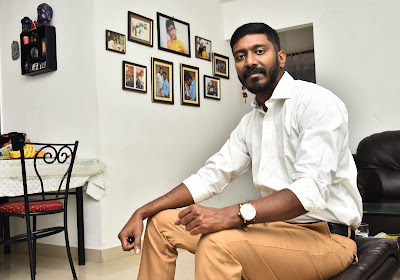At
the ‘Outsider Art’ exhibition held at Fort Kochi recently,
autistic youngsters displayed their remarkable artistic talent
Photos: Rohit Anand in front of his work; Ajai Vadakkath (centre) with a few artists; artist Pranav Nair's work, 'Why I Love Google'. Pics by A. Sanesh
By
Shevlin Sebastian
The
tall Rohit Anand, an 18-year-old autistic boy strides into the
Dravidia Gallery in Fort Kochi and goes straight to his exhibit.
There are three paintings side by side, all of them acrylic on
canvas. In the first, titled, ‘I want’, there is an image of him
in the forefront, head bowed, eye closed, and just where his head is,
there is an image of a brown-skinned young girl, with black hair,
prominent lips and flower-type earrings. She is looking ahead
expressionlessly. Just next to her is another image, showing the back
of her head.
“This
is Manasi,” he says, pointing at the girl. “She used to come to
‘Sense Kaleidoscopes’ (an autism school in Bangalore) where I
study. Now she is not there. I miss her. I like Manasi a lot. We used
to play snakes and ladders.”
Listening
to him is Akshayee Shetty, the founder-director of ‘Sense’.
“Rohit has been thinking about girls,” she says. “Children with
autism have the same needs as teenagers everywhere. If the youngster
is thinking of wanting a girlfriend, there is nothing wrong with
that.”
In
the next work, Rohit is again in the forefront, his mouth opened in
anger, his teeth bared, rage in his eyes, while above him is a mirror
that has been broken in places. “On November 2, 2015, it was my
friend Ayush Bambani’s birthday,” says Rohit. “He was crying a
lot. The sound angered me. So I broke a mirror.”
And
in the third work, titled ‘Voices’, his face is distorted, in the
manner of a Salvador Dali painting. There are word blurbs all around,
with angry messages in it. “I feel very upset when my mother or
somebody else scolds me,” says Rohit.
These
paintings were displayed at the ‘Outsider Art’ exhibition where
64 works by 38 artists were on display. The show, held recently, was
organised by former Navy commander and art lover, Ajai Vadakkath, and
his wife Priti, who are parents of a 17-year-old autistic boy.
The
idea for the exhibition came to Ajai when in July last year he came
across the works of Ayush Bambani and was impressed. Ajai has an idea
about art since Priti is an artist while his brother Vivek Vilasini
had been a featured artist in the first edition of the Kochi Muziris
Biennale. As a result, Ajai had been a volunteer at the inaugural
Biennale and became friends with co-founder Bose Krishnamachari.
So
he sent the images to Bose and the latter was impressed. Then Ajai
said, “Bose, it's about time these kinds of works are brought to
the mainstream. Can we get the support of the Biennale Foundation?”
Bose
immediately agreed. Then Ajai, who is part of many autism groups sent
out the message to parents in Delhi, Chennai, Bangalore and Hyderabad
that he was looking for artworks. “There is another huge autism
group in Yahoo groups, more than 4000 parents,” says Ajai. “I
mentioned clearly that this is not a sympathy exhibition. It is
merit-based. In fact, Bose told me, ‘I will look at the art, I will
not look at the level of disability, nor the age. I don’t want to
be biased’.”
The
exhibition has many impressive artworks, with children of varying
disabilities producing some remarkable work, mainly in the abstract
style.
The
33-year-old Swaminathan, one of the oldest participants, sees an
image but he only knows how to represent it through lines. Not
surprisingly, his work, ‘Chennai Central’ shows the railway
station through lines.
On
the other hand, Pranav Nair prefers to use triangles, rectangles,
circles and squares. Ayush likes dogs, so he draws the animal all the
time. Some of the other artists who participated included Sidharth
Murali, Sachin Joshi, Indubala, Sakshi Chawla, Kalash Kariappa,
Sanjay, Tanisha Lahiri, Melvina and Kajal Ashar.
Meanwhile,
as Bose walks around on the inaugural day, he shakes his head and
says, “They have a genuine talent. I did not know that so many of
them were so artistic. This is the first of its kind for the Biennale
Foundation. We would like to do similar exhibitions in other cities.”
Ajai
nods his head happily when he hears that and says, “It is
heartwarming when talented autistic children are able to express
themselves through their art.”
(Sunday
Magazine, The New Indian Express, South India and Delhi)





















